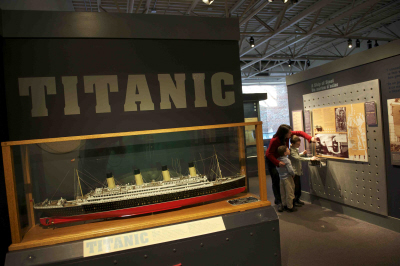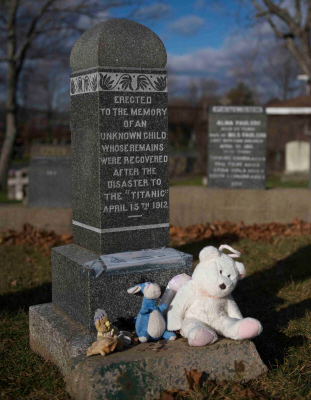

Titanic Exhibition (Photo copyright Maritime Museum of the Atlantic, Nova Scotia)
Sites linking the story of the Titanic can be found on both sides of the Atlantic, from the place where it was built to the final resting place of some of the victims. While most sites are in areas directly affected by the Titanic, interest in the subject has led to museums being set up elsewhere.
Titanic Visitor Experience, Belfast City, Northern Ireland
Opened in 2012, this is an unusual building designed to resemble the hulls of four ships. It contains a major exhibition relieving the story of the Titanic from its construction to maiden voyage. There are several large reconstructions including an undersea exploration experience known as the ‘immersive theatre’. This enables visitors to explore the wreck, via live links to current undersea investigations. Visitors pass through the original Harland & Wolff gate, ascend a replica of one of the huge pillars of the Arrol Gantry before embarking on the Shipyard Ride. This is an electronic dark ride using special effects, animations and full scale reconstructions to recreate the reality of shipbuilding in the early 1900’s. Exiting the ride, visitors see a large window onto the slipways on which the Titanic once rested. The view switches to a superimposed image of the vessel on the slipway. The building has been constructed on the site of the shipworks where RMS Titanic was built.
Titanic’s Dock and Pump-House, Queens Road, Belfast
This was the last place that the Titanic rested on dry ground. The dock was built to accommodate the Titanic and her sister ships, the Olympic and Britannia . It is the largest dry dock every constructed and is in near perfect condition. The steel dock gate measures 150 ft at its widest point, it is 44 ft deep and 887 feet long. The Pump House contains the pumps used to drain the dry dock in 100 minutes. An audio visual presentation includes rare footage of the Titanic at the dock in 1912. Guided tours of the Dock and pump house are available daily.
SS Nomadic, Hamilton Dock, Queen’s Road, Belfast
This was the tender used to ferry passengers from Cherbourg to the decks of the Titanic. Access is only possible via a guided tour led by the granddaughter of Titanic crew member, Thomas Millar.
Belfast Harbour Commissioners, Corporation Square, Belfast
Inside this Italianite style building is the Captain’s table and chairs which were intended for use in the rooms of Captain Smith on the Titanic. They were not ready at the time of sailing and waited in Belfast for installation at a later date. Guided tours of the building are available for groups by arrangement.
Belfast City Hall, Donegall Square North, Belfast
Outside the City Hall is a memorial to the 22 men from the area who lost their lives in the disaster.
Ulster Folk and Transport Museum, Belfast
The exhibition illustrates the ship’s construction, loss and legend using original Titanic material together with vintage photographs, recordings, newsreels and music. The museum tells the story of other industries in the area including the Belfast Linen Industry which provided all the tableware and bed linen for the Titanic. This is a living museum staffed by re-enactors so visitors can discover cottages, farms, schools, shops. Watch Titanic movies in the Silent Cinema and dress in period costume to get a picture taken in the surroundings of the Titanic.
Ulster American Folk Park, Castletown, Omagh, Co Tyrone
Follow the emigrant trail from the thatched cottages of Ulster, go on board emigrant ships leading to the log cabins and settler life of America. A special exhibition on the Titanic: Window on Emigration looks at the stories of the Third Class Irish passengers who travelled on the Titanic.
SeaCity Museum, Southampton
SeaCity tells the story of Southampton and its involvement with the sea. The Titanic display tells the story of the people of Southampton who were affected by the disaster
La Cité de la Mer, Cherbourg, France
There is a permanent exhibition area devoted to the history of emigration and the role of the Titanic. Part of the exhibition is located in the former Cherbourg passenger terminal baggage room which would once have housed the luggage destined for the Titanic. Slides, films and archive photos allow visitors to relive the journey of emigrants heading for America. Other exhibits relate to the journey of the Titanic, showing events from the crew’s point of view as well as that of the passengers.
Cobh, Eire
Formerly known as Queenstown, this town was the Titanic’s last port of call before setting off across the Atlantic. There is a memorial to the victims of the Titanic. The White Star offices in Cobh have been turned into a museum containing a Titanic themed display. Visitors can find out what happened to the 123 passengers who boarded the ship here. A Titanic Trail walking tour takes visitors through the town where buildings, streets and piers have not changed since the Titanic collected its final passengers at the harbour.

Unknown Child Memorial
Fairview Lawn Cemetery, Chisholm Avenue off Connaught Ave, Halifax, Nova Scotia, Canada.
121 victims of the sinking of the Titanic are buried here. Their bodies were rescued following the disaster. The graves include that of Jack Dawkins, a coal trimmer on the Titanic. His name was later used to create a heroic character for the 1997 blockbuster film Titanic. There is also a memorial to the unknown child. In 2007, DNA testing allowed the 18 month old child to be identified as Sidney Goodwin from Melksham, Wiltshire.
Mount Olivet Cemetery, 7076 Mumford Road, Halifax, Nova Scotia, Canada
19 victims of the Titanic are buried in this Roman Catholic cemetery, including J.P. Clarke, the bass player in the band.
Cape Race, Newfoundland, Canada
The Marconi Marine Radio Station at Cape Race was the closest land based wireless station to receive the Titanic’s distress signal. From here the ship’s fate was broadcast around the world. A museum has been set up reconstructing the station named for the Myrick family, generations of whom worked here from 1874 to 2007. The exhibition shows how the Myrick family co-ordinated the rescue efforts to find survivors of the disaster.
Museum of the Atlantic, 1675 Lower Water Street, Halifax, Nova Scotia, Canada
The museum’s Titanic The unsinkable Ship exhibition tells the story of the disastrous voyage and has the largest collection of wooden Titanic artefacts worldwide. It contains many artefacts including an almost perfectly preserved deckchair, richly carved pieces of the grand staircase and a pair of child’s shoes. These items were all pulled from the water within weeks of the sinking by the crew aboard ships from Halifax searching for victims. There is also the log of the RMS Titanic wireless messages. There is also a separate exhibition dealing with the Battle of the Atlantic during the Second World War.
BIO (Bedford Institute of Oceanography), 1 Challenger Dr, Dartmouth, Halifax, Nova Scotia, Canada
BIO is Canada’s largest centre of ocean research. Its innovative Titanic exhibition includes a model of what the Titanic looks like down on the ocean floor, together with images from the 1991 explorations.
Mystic Aquarium, Boston, New England, USA
Titanic – 12,450 Feet Below is an exhibition designed to commemorate the 100th anniversary of the liner’s maiden voyage. It is based mainly on the work of Dr Robert Ballard who identified the exact location in 1985. His knowledge has been combined with that of Walt Disney Imagineer Tim Delaney to bring the vessel vividly alive. The exhibition begins by focusing on the glamour of a luxury liner complete with elegant staterooms. Icebergs come into site and morse code warnings are sounded. Visitors can experience the scale of the Titanic’s engine room with its speaking tubes, wheels and horns. There are displays designed to show the power of the ocean and the resultant headlines which attracted attention worldwide. It looks too at the myths and legends that have developed and the wreck seen by Dr Ballard via the remotely controlled vehicles.
Merseyside Maritime Museum, Albert Dock, Liverpool
An exhibition on the Titanic, Lusitania and Forgotten Empress which contains an original 20’ builders model of the Titanic, a survivors lifejacket as well as spectacles, wristwatches and banknotes.
Titanic Honour & Glory
This is a national travelling exhibition that has been visiting UK cities for several years. It is dedicated to preserving the legacy of the White Star Line and their fleet of ships. The exhibition contains many rare artefacts drawn from the largest private collection in Scotland. It includes china, silver and oak panelling. There are dining chairs and other movie props and costumes used in James Cameron’s film Titanic. The exhibition has already been seen at Swansea, Down County, Carrickfergus, Chatham Historic Dockyard.
The Titanic Museum, Pigeon Forge, Tennessee, USA
The museum has a half size replica of the forward section of the doomed ship and the fateful iceberg, as well as many artefacts. It houses the 26ft long model film direct James Cameron used in his 1997 movie Titanic. There are several replica rooms such as the first class cabin parlour recreating the scene where Leonardo DiCaprio drew Kate Winslet’s portrait in the film. An unusual feature is the three lengths of decking simulating the different angles that the ship adopted as it slid beneath the waves.
The Titanic Museum, Branson, Missouri, USA
As with its twin museum in Pigeon Forge, there is a half size scale replica of the Titanic’s front bow and a 30 ft tall reproduction of the icebertg. There is a replica of the famous Grand Staircase in the Titanic’s first class section, and a Memorial Wall etched with the names of all those who sailed on the ship.